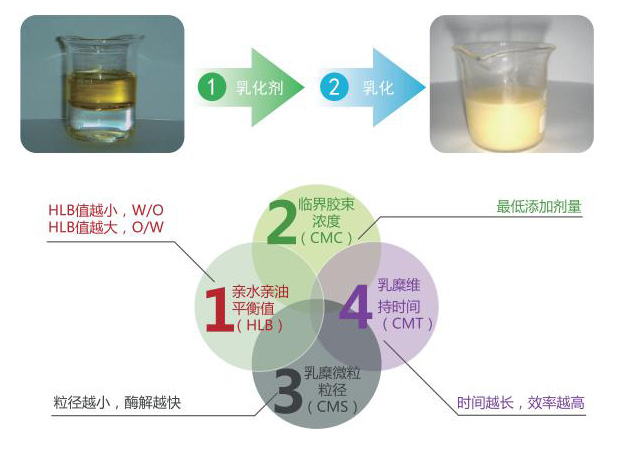Kyocene
The importance of fat in animal production:
1. Fat is an important form of energy storage for animals, and the main component of cell membranes, helping to maintain the complete form of cells;
2. Fat has a higher net energy and is an important source of energy for animals. The energy value of fat is about 2.25 times that of carbohydrates and protein;
3. Fat provides essential fatty acids for livestock and poultry production, and fat-soluble nutrients in feed such as pigments, vitamins A, D, E, K, etc. must be dissolved in fat before they can be effectively absorbed by the body.
The digestion and absorption process of fat in animals:

Factors affecting the application of fat in animal production:
1. The transportation of fat in the body and the enzymatic reaction of lipase to decompose fat are carried out in the water phase. The hydrophobicity of fat is the primary factor affecting the effect of fat application;
2. Animal's physiological structure, life and production environment;
1) Insufficient bile salt secretion in young animals;
2) The length of the digestive tract of animals of different species is quite different;
3) The animal is in a special stress state, and the concentration of its own bile acid and its salt is reduced.
3. Types of fats, such as saturated fatty acids are more difficult to be used by animals than unsaturated fatty acids;
4. The difference in energy value between different sources of the same fat and different batches;
5. The amount of fat added in feed affects the application effect of fat in animal production.
Effective ways to improve the application effect of fat in animal production
※Surfactants with hydrophilic groups (hydroxyl groups) and hydrophobic groups (hydrocarbon long bonds);
※Reduce the interfacial tension of the two phases, which is beneficial to the formation of spherical chylomicrons.

Standards for measuring the pros and cons of biological emulsifiers

★The effect of adding Junengsu on the performance of weaned piglets
The effect of Junengsu on the growth performance of weaned piglets
| Project/Group | Control group 1 | Test group 1 | Control group 2 | Test group 2 |
| Average initial weight (kg) | 8.75±0.23 | 8.29±0.20 | 8.59±0.15 | 8.45±0.16 |
| Final weight (kg) | 13.99±0.83 | 13.98±0.66 | 13.92±0.93 | 13.94±0.91 |
| Average daily weight gain (g) | 308.48±6.48 | 334.22±5.90 | 313.97±5.33 | 322.82±4.82 |
| Average daily feed intake (g) | 417.39±32.21 | 425.00±32.39 | 408.53±31.03 | 412.94±30.21 |
| Feed to meat ratio (F/G) | 1.31±0.12 | 1.27±0.10 | 1.30±0.09 | 1.28±0.08 |
| Diarrhea rate/% | 4.8a | 1.3b |
4.23a |
0.4b |
Different lowercase letters on the shoulders of peer data indicate significant surprises (P<0.05), and no letters or the same letters on the shoulders of the data indicate insignificant differences (P>0.05). The following table is the same
★The effect of Junengsu on the performance of 16-35-day-old meat ducks
| Group |
Number of ducks at the end of the test
(only)
|
Total weight
(Kg)
|
Consumption
(Kg)
|
Average weight
(Kg/only)
|
Feed to meat ratio |
| Control group | 970 | 2822 | 5790 | 2.91 | 2.05 |
| test group | 970 | 2832 | 5670 | 2.92 | 2.00 |
★Recommended use plan
Plan 1:
Add Juenengsu 300-500g/ton material
Reduce energy 25-30 kcal/kg feed
Plan 2:
According to the total crude fat 1.0% Add macro energy
10% of total crude fat reduce fat
★The effect of Junengsu on the production performance of the big yellow chicken in the meat
|
Day |
Treatment group |
Junengsu (Jiangsu Youheng) |
Contrast |
||||||
|
14 to 28 |
Test number |
61 |
59 |
61 |
- |
61 |
61 |
60 |
- |
|
Average net value added (g) |
488 |
488 |
472 |
482 |
460 |
523 |
460 |
481 |
|
|
Total material consumption (Kg) |
59.1 |
55.6 |
57.5 |
- |
55.8 |
63.2 |
57.8 |
- |
|
|
Average feed intake (g) |
1001 |
975 |
942 |
973 |
930 |
1036 |
963 |
976 |
|
|
Feed to meat ratio |
2.05 |
2 |
2 |
2.02 |
2.02 |
1.98 |
2.09 |
2.03 |
|
|
28 to 45 |
Test number |
59 |
57 |
61 |
- |
60 |
61 |
60 |
- |
|
Average net value added (g) |
944 |
971 |
1007 |
974 |
850 |
962 |
919 |
910 |
|
|
Total material consumption (Kg) |
118 |
121 |
124 |
- |
106 |
126 |
112 |
- |
|
|
Average feed intake (g) |
2070 |
2122 |
2032 |
2074 |
1827 |
2081 |
1898 |
1914 |
|
|
Feed to meat ratio |
2.19 |
2.18 |
2.02 |
2.13 |
2.15 |
2.16 |
2.06 |
2.12 |
|
|
all period
|
Net heap value (g) |
1667 |
1693 |
1715 |
1692 |
1543 |
1726 |
1613 |
1627 |
|
Feed intake (g) |
3399 |
3426 |
3302 |
- |
3084 |
3457 |
3191 |
- |
|
|
Feed to meat ratio |
2.04 |
2.02 |
1.93 |
2 |
2 |
2 |
1.98 |
2 |
|
Add 500g instead of 6kg fat
★Experimental results of Junengsu on the growth performance of white feather broilers
The effect of adding different levels of macroneng on the growth performance of 22-42d broilers (25% content)
|
Deal with |
Diet |
Meganol |
22 days weight (g/piece) |
42 days weight (g/piece) |
Body weight gain (g/piece) |
Material to weight ratio |
||||
|
Mean |
SD |
Mean |
SD |
Mean |
SD |
Mean |
SD |
|||
|
2 |
NC |
- |
766.5 |
24.3 |
2063.0 |
153.2 |
1296.0 |
154.9 |
2.42 |
0.10 |
|
3 |
NC |
200 |
790.2 |
13.2 |
2148.0 |
71.8 |
1358.0 |
68.8 |
2. 39 |
0.13 |
|
4 |
NC |
350 |
777.4 |
16.6 |
2118.0 |
97.4 |
1340.0 |
96.6 |
2.40 |
0.14 |
|
5 |
NC |
500 |
767.1 |
11.0 |
2179.0 |
110.5 |
1412.0 |
110.0 |
2. 30 |
0.07 |
|
6 |
NC |
600 |
762.6 |
63.0 |
2215.0 |
190.3 |
1452.0 |
173.3 |
2.31 |
0.26 |


